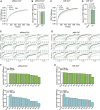Screening of Hydrocarbon-Stapled Peptides for Inhibition of Calcium-Triggered Exocytosis
- PMID: 35814209
- PMCID: PMC9258623
- DOI: 10.3389/fphar.2022.891041
Screening of Hydrocarbon-Stapled Peptides for Inhibition of Calcium-Triggered Exocytosis
Abstract
The so-called primary interface between the SNARE complex and synaptotagmin-1 (Syt1) is essential for Ca2+-triggered neurotransmitter release in neuronal synapses. The interacting residues of the primary interface are conserved across different species for synaptotagmins (Syt1, Syt2, Syt9), SNAP-25, and syntaxin-1A homologs involved in fast synchronous release. This Ca2+-independent interface forms prior to Ca2+-triggering and plays a role in synaptic vesicle priming. This primary interface is also conserved in the fusion machinery that is responsible for mucin granule membrane fusion. Ca2+-stimulated mucin secretion is mediated by the SNAREs syntaxin-3, SNAP-23, VAMP8, Syt2, and other proteins. Here, we designed and screened a series of hydrocarbon-stapled peptides consisting of SNAP-25 fragments that included some of the key residues involved in the primary interface as observed in high-resolution crystal structures. We selected a subset of four stapled peptides that were highly α-helical as assessed by circular dichroism and that inhibited both Ca2+-independent and Ca2+-triggered ensemble lipid-mixing with neuronal SNAREs and Syt1. In a single-vesicle content-mixing assay with reconstituted neuronal SNAREs and Syt1 or with reconstituted airway SNAREs and Syt2, the selected peptides also suppressed Ca2+-triggered fusion. Taken together, hydrocarbon-stapled peptides that interfere with the primary interface consequently inhibit Ca2+-triggered exocytosis. Our inhibitor screen suggests that these compounds may be useful to combat mucus hypersecretion, which is a major cause of airway obstruction in the pathophysiology of COPD, asthma, and cystic fibrosis.
Keywords: airway obstruction; asthma; cystic fibrosis; mucin secretion; neurotransmitter release; stapled peptide; stimulated membrane fusion.
Copyright © 2022 Lai, Tuvim, Leitz, Peters, Pfuetzner, Esquivies, Zhou, Czako, Cross, Jones, Dickey and Brunger.
Conflict of interest statement
The authors declare that the research was conducted in the absence of any commercial or financial relationships that could be construed as a potential conflict of interest.
Figures





References
Associated data
Grants and funding
LinkOut - more resources
Full Text Sources
Other Literature Sources
Miscellaneous

